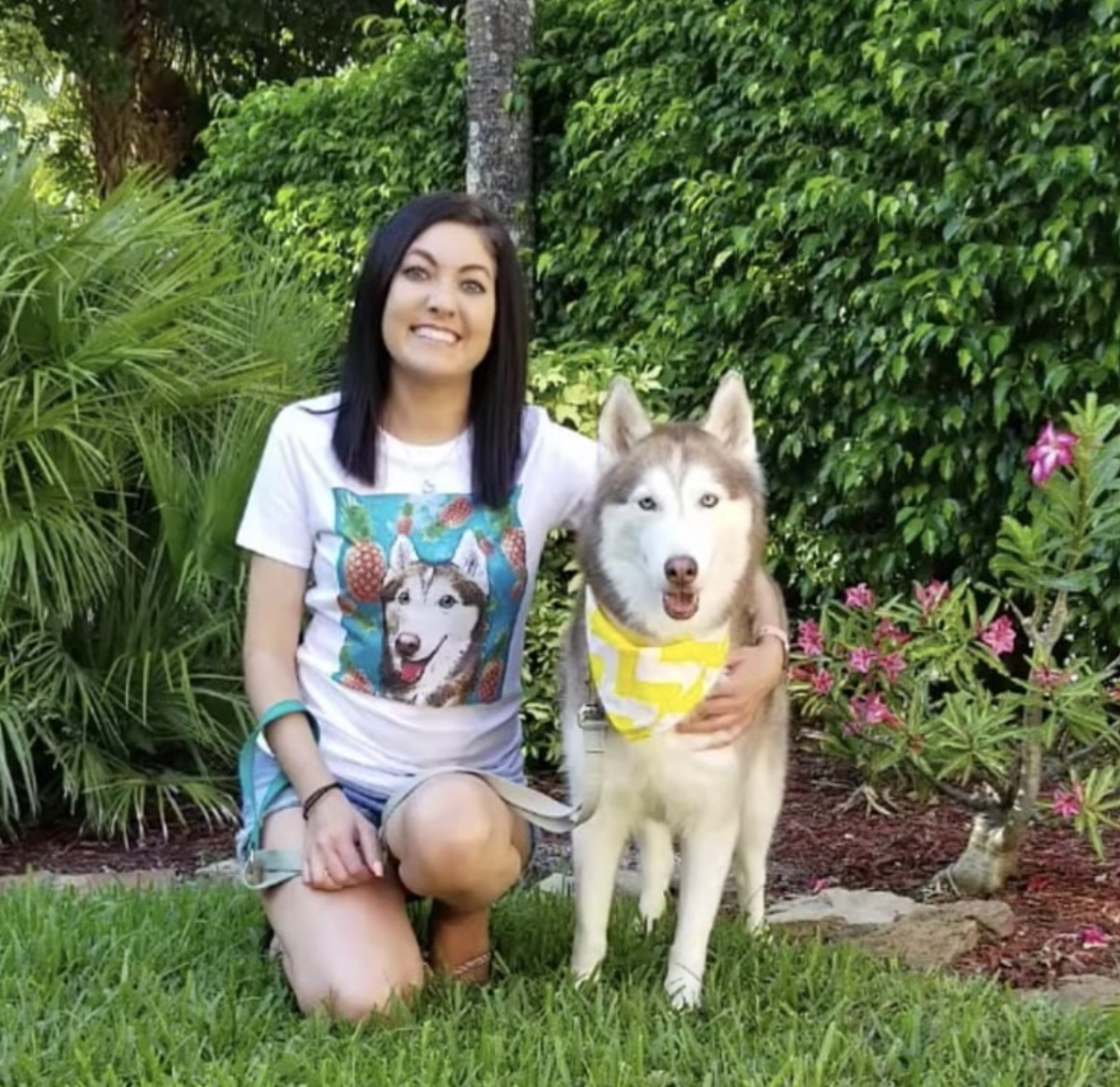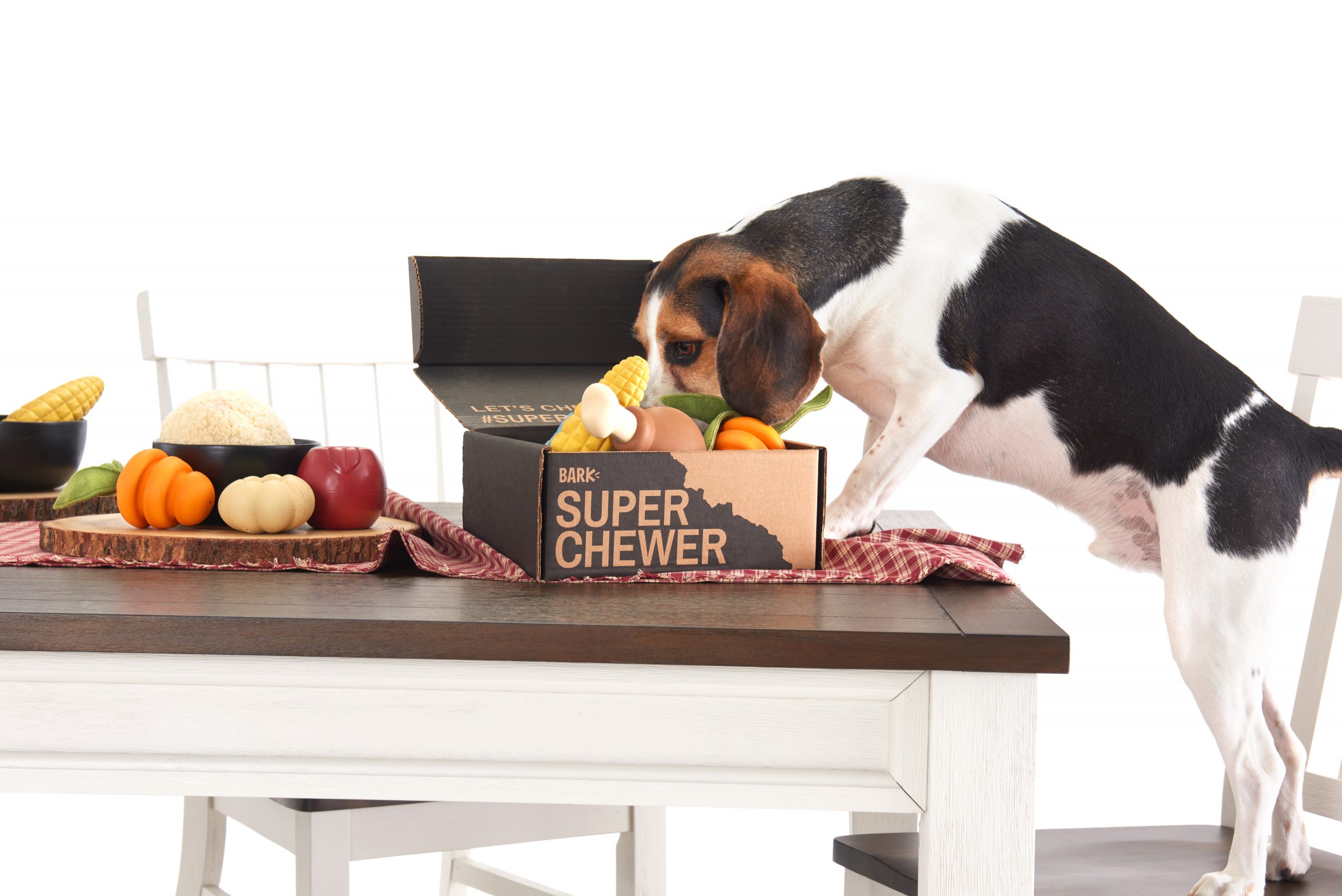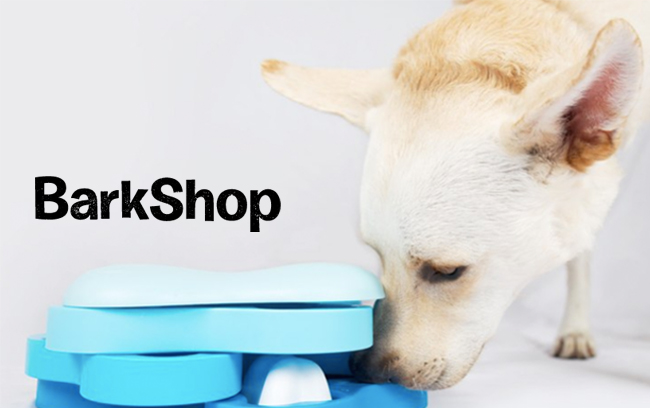Congrats! You just brought home your ridiculously cute new puppy! This first month home is exciting. It’s nerve-racking. It’s fun. It’s stressful. It’s all the ups and downs that taking on the responsibility of raising the most adorable pup in the world should be!


What Do I Need To Know To Raise A Brand New Puppy?
This cheat sheet for puppies 8–12 weeks old is the first in our series to break down the most important steps for your puppy’s health and wellness, training, socialization, nutrition, safety, and physical development during each month of a puppy’s first year.
| Essential Task Checklist For Puppy’s First Month Home (Ages 8–12 Weeks Old) ☐ Choose a veterinarian and make an appointment. ☐ Decide on a puppy diet. ☐ First vet exam. First vaccines (DA2PP or DAP) Deworming Heartworm, flea, and tick medication Discuss future spay/neuter options and breed-specific procedures. ☐ Purchase necessary puppy products (list at bottom of article). ☐ Check that toys are puppy safe (proper size & firmness for puppies). ☐ Puppy-proof your home . Remove poisonous plants/household toxins. Pick up electrical cords/charging cables. Secure or move anything you don’t want your puppy chewing or peeing on. Check for any vulnerabilities in outdoor fences or doors (holes, loose doorknobs, etc). ☐ Introduce puppy to at least 90 different enjoyable experiences (sights, sounds, smells, people) by the time they hit 14 weeks old. ☐ Set routines for eating & bathroom breaks. ☐ Begin basic training. Potty training Not biting Learning their name Sit command Walking on a leash ☐ Gently touch their ears, paws, mouth, face, etc. daily during cuddles to prepare them for future grooming & health checks. ☐ Familiarize them with tooth-brushing & nail-trimming routines. ☐ Make sure your vehicle is puppy safe & begin introducing them to the inside of the car. Purchase travel kennel or puppy seatbelt with harness (not collar!). Never let puppy loose in car or in bed of a pickup truck. ☐ Check city & state dog licensing requirements. ☐ Consider purchasing pet insurance early to avoid pre-existing condition exemptions. ☐ Put emergency phone numbers in your phone. Nearby emergency vet that’s open 24/7 Animal poison control (ASPCA: (888) 426-4435) |
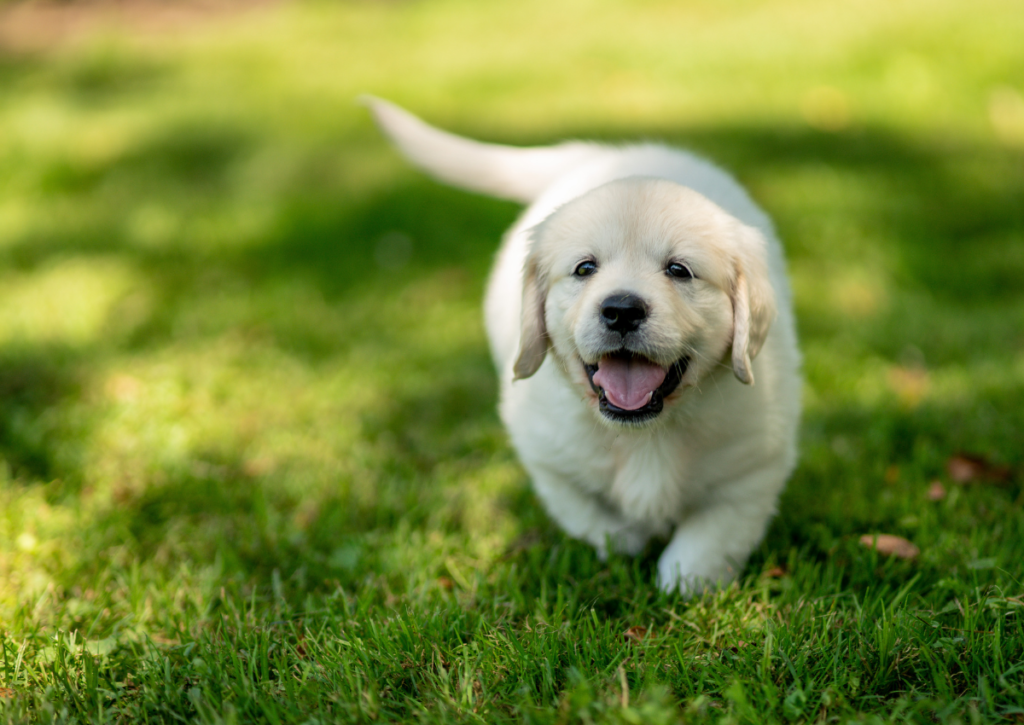

What Puppy Growth Changes Should You Expect In The First Month Home?
Physical Growth
All puppies grow like weeds, but different sized breeds tend to grow at different rates. It’s important to keep physical development needs in mind.
Toy And Small Dog Breeds1:
- Tend to drink less water, so dehydration can become a problem if not monitored.
- Have fragile jaws. Be careful to choose smaller kibble and smaller, gentler toys.
- Prone to injuring legs from jumping off furniture or jumping out of your arms when being carried. These injuries may require surgery and are difficult to heal. Consider purchasing steps or ramps for furniture, a collar with a jingle bell to alert you that they’re underfoot to avoid hurting them, and a proper carrier rather than carrying them in your arms—as cute and cuddly as they may be!
Medium Dog Breeds1:
- Many medium-sized pups have been bred for their energy and drive to work outside. These guys are going to need extra exercise and play sessions to keep them physically healthy and happy. Dedicate time to being active to avoid your puppy putting that energy toward furniture and shoe destruction!
Large And Giant Dog Breeds1:
- Diets rich in vitamin C and E, plus glucosamine and chondroitin, may be needed to help protect your large breed pup’s joints later in life (ask your vet!).
- Appropriate calcium is also important during growth.
- You may notice puppies being very uncoordinated and clumsy in these early stages. We all have some awkward growing years, so try to be patient, and cut them some slack if they’re a little doofy in the first few months!
Puppy Growth Chart1, 2
| Dog Size | Weight | Rapid Growth Period | Timescale To Fully Grown | Total Lifespan |
| Toy (Extra Small) | Less than 8 lbs | Birth–11 weeks | 6–12 months | Approx 15+ years |
| Small | 9–22 lbs | Birth–4 weeks | 8–12 months | 14–16 years |
| Medium | 23–55 lbs | Birth–16 weeks | 8–18 months | 10–12 years |
| Large | 56–99 lbs | Birth–18 weeks | 11–18 months | 9–12 years |
| Giant | Over 100 lbs | Birth–20 weeks | 12–24 months | 7–9 years |
Puppy Teeth
Puppies have a set of 28 deciduous (non-permanent) teeth that erupt (pop up above the gum line) between 3–12 weeks of age. This set of puppy teeth will later be replaced by a set of 42 permanent adult teeth3.
If you’ve just brought your 8-week-old puppy home, you’re likely to notice that their incisors (the stubby front teeth) and their canines (the fang-like teeth) are already visible. Depending on the breed and size of your pup, their premolars may already be visible by the time you first bring them home, or they may come in within this first month3. They may even begin losing a puppy tooth or two towards the end of the month.
Schedule Of Puppy Teeth Coming In
| Incisors | 3–5 weeks |
| Canines | 3 weeks |
| Premolars | 4–12 weeks |
Puppy Teeth To-Do:
It’s a good idea to begin introducing your puppy to a dental routine as early as possible to get them used to the process. At this early stage, a finger brush along with some puppy toothpaste can be helpful. Check out this article for some helpful tips to keep your pup’s teefers in tip-top shape!


Puppy Nails & Dewclaws
Puppies’ nails are constantly growing, just like our human nails, which means they also need to be trimmed from time to time too. But don’t go grabbing your own nail clippers! Canine nails require specialized clippers or nail grinders capable of trimming without splitting them.
Most dogs have four toenails on each paw, plus a dewclaw on each front paw—some breeds have them on the back feet as well. Although dewclaws can be somewhat useful for traction or to help your pup hold down a chew toy, these extra digits have very limited function4 and are often removed early on in a puppy’s life or during their spay/neuter. This is done to keep the dewclaws from becoming troublesome for your pup and causing them pain if they get caught on things like carpet, clothing, or their own toys.
Puppy Nails To-Do:
A puppy’s nails can start being trimmed by the time they’re 6 weeks old, which means it’s a good idea to start introducing them to nail clippers right away. This introduction should be done slowly, even starting with one nail per day and including lots of treats. It’s important to keep in mind that a blood vessel runs through the middle of your pup’s nails, so you never want to trim them back too far. Hitting the “quick” is painful and causes bleeding similar to trimming a human nail back too far.
Check out this walk-through on how to trim your pup’s nails!
Energy (Eat, Sleep, Poop)
Growing takes a lot of energy! That’s why your puppy’s main activities in this first month home are going to revolve around eating, sleeping, and potty breaks.
Eat: At 8 weeks old, depending on breed, your puppy will need 4–6 meals per day1.
Sleep: At 8 weeks, you can expect your puppy to sleep about 18–22 hours per day5! We like to refer to this as the Nap-o-saurus Rex stage.
Potty Breaks: From ages 6–14 weeks, you can expect your puppy to need 8–10 potty breaks per day6.
Brain Development & Personality
In this first month home your puppy is going through their Socialization Period of development, which lasts from about 6–14 weeks old, as well as their Fear Impact Period. What your puppy learns and experiences during this time is crucial in laying the foundation for their personality as an adult. The more enjoyable experiences they’re introduced to in the first month, the less likely they are to have fears and aggression as an adult dog1. This next section goes into greater detail about this period of puppy brain and personality development.
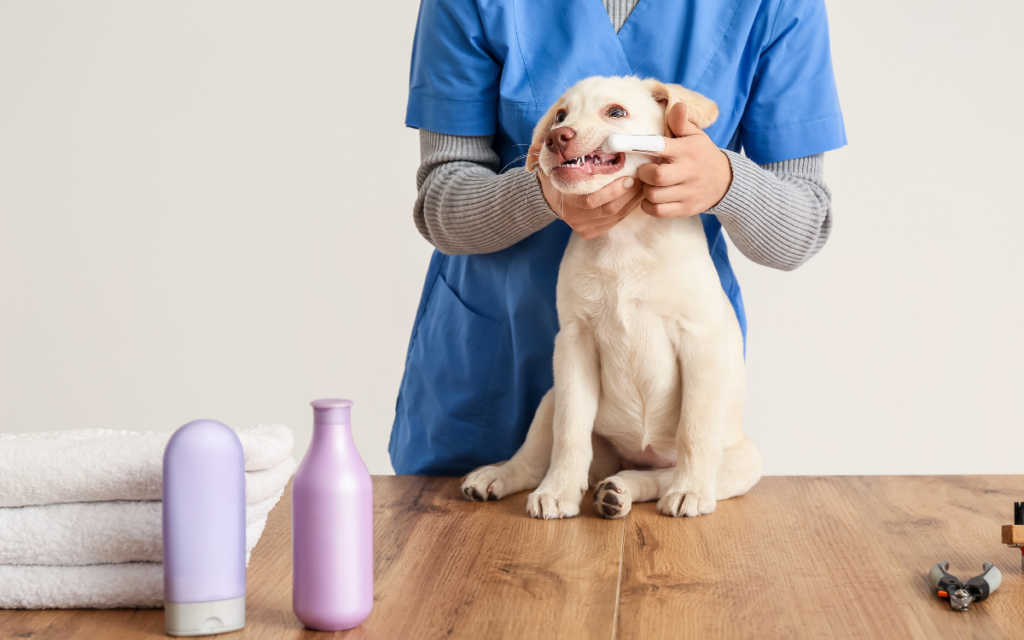

What Puppy Behavior & Personality Changes Can You Expect In The First Month Home?
Socialization With Dogs & Humans
The first month at home is an extremely important time when it comes to developing puppies’ social skills, and helping them start off on the right foot (er, paw, in this case). Your pup’s brain is starting to figure out who and what to be friends with, as well as who and what to be afraid of.
Around weeks 8–10, their natural fear response begins to kick in, so it’s important to introduce them to all kinds of new, low-stress experiences in a safe and fun way to avoid emotional instability3. Since your puppy is building its strongest lifelong connections with fears at this point, be careful not to throw them into high-stress situations that could make them fearful, aggressive, anxious, or reactive later in life3.
New Sights, Sounds, & Smells
It’s best to start small by introducing them to a new situation for a few seconds to gauge their reaction. If they show signs of stress or fear, such as a tucked tail, licking lips, yawning, shaking, or laying their ears back, just remove the object, or remove your puppy from the situation. Give them a treat and praise to help them associate positive things with that slightly scary thing they just encountered, then try again later1. Here’s a list of objects, people, and situations to introduce them to:
- Men, women, & children (supervised) of all ages, heights, ethnicities, genders, etc.
- Other pets in the house (supervised for short periods).
- Other vaccinated dogs that you know well (NOT the dog park until your puppy is fully vaccinated, and even then, take caution).
- Animals from a distance (try letting them look out a screened window).
- People using medical assistive devices (puppies need to understand that objects like canes, walkers, wheelchairs, prosthetics, medical devices, etc. are normal and not scary).
- People with physical differences from those in your family (beards, glasses, braces, different-colored hair).
- People in uniforms (mailmen, police officers, etc).
- People riding bikes, skateboards, roller-blades, etc.
- Walk them outside where they may safely see cars, garbage trucks, mail trucks, bikes, etc.
- Inanimate objects like phones, keys, balloons, sports gear. Let them look at, hear, and smell objects. Do not let them chew or touch objects that could cause them harm or that you don’t want damaged.
- Introduce noisier objects like vacuums or outdoor yard equipment more slowly. Try leaving an unplugged vacuum in the same room for a day. Once they’re ok with seeing the vacuum, take it to a separate room and turn it on for a few seconds so your puppy can hear it at a distance without fear, and go back to reward with a treat. Slowly work your way up to running the vacuum in the same room for a few seconds and give treats until your puppy can calmly handle the vacuum running for longer periods of time.
Acclimating A Puppy To Touch
Why It’s Important:
Holding a puppy and touching their little nose and toes is all but irresistible, but it’s also important to get them used to you handling them gently without causing stress. This helps make future events like nail trimming, baths, medication application, or checking for injury much easier for both of you1.
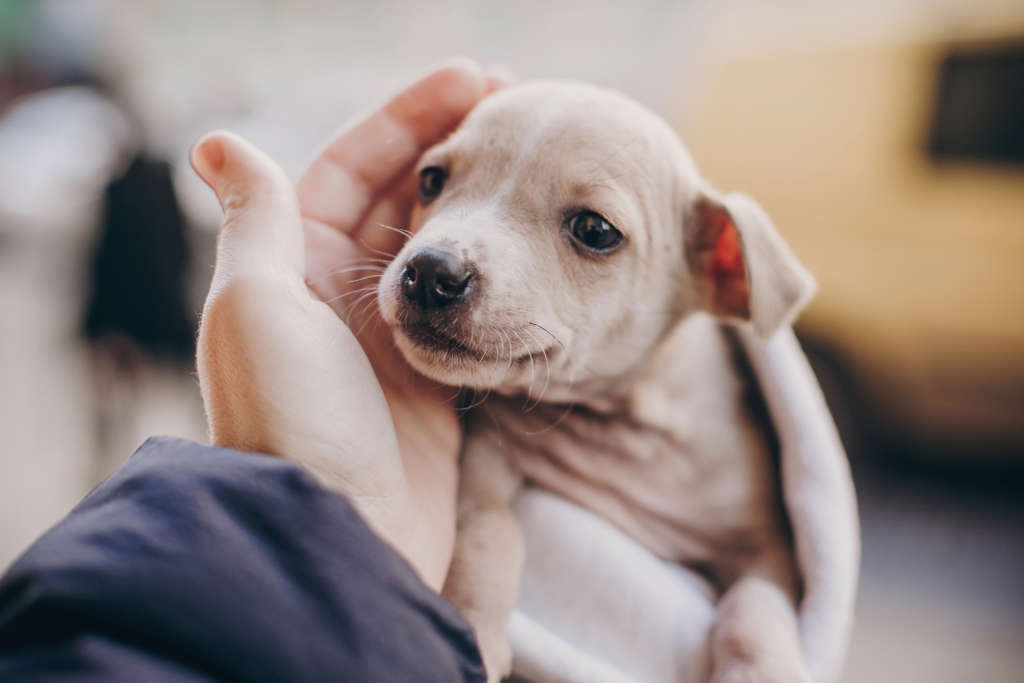

Puppy Touch Acclimation To-Do:
Handle your pup gently for short periods of time, and slowly build up to touching areas that your pup is more sensitive about. Initially, give a small treat after each touch, and slowly reduce treats as they get used to each touch (but continue happy praise!). This should be fun for both of you1!
- Touch each paw, toenail, paw pad, and webbing in between toes.
- Touch their head, around their eyes, around the ears and gently inside ears, around their muzzle, inside their mouth along their teeth and gums, and their neck.
- Touch their body, including their underbelly, sides and back, down each leg, their bum, their chest, and gently lift and touch their tail.
- Try all of these touches while they’re sitting, standing, and lying down. But keep in mind not to force them into these positions, which can cause stress.
Visiting New Places
New Places To-Do:
For the same reason this is an important period of time to introduce your puppy to new people and objects, it’s equally as important to visit enjoyable new places with your pup. Don’t forget that before your puppy is fully vaccinated, they’re highly susceptible to disease when you go out. It’s best to carry them in your arms in public places (pet stores, vet offices, parks) during the first month to avoid contracting disease.
Try taking your pup on trips to:
- The inside of your car. As strange as that may sound, to your pup, your vehicle is a new place. Cars can be scary for puppies, so before going on trips, try exploring the inside of the car with them while it’s turned off. Begin with letting them explore freely with supervision, and give lots of treats. Slowly work your way up to introducing a travel kennel or puppy seatbelt, until they’re fully comfortable in a moving car.
- Houses other than your own (friends or family’s houses who have vaccinated pets).
- The lobby of the vet office to say hello without the stress of a vet exam (do not let them interact with other pets in the office!).
Meeting The Veterinarian
To set your puppy up for success as an adult dog, it’s essential to make vet appointments as fun as possible. This means:
- Find a veterinarian you like and trust.
- It can be helpful to take your puppy in to meet the staff first without an exam. Giving treats during this visit can help your puppy associate the vet with something fun.
- Watch your pup’s body language for signs of stress (tail tucking, licking lips, flattened ears).
- Take things slowly and give lots of encouragement. Use cheerful voices!
Check out these other helpful tips for a less stressful vet visit!
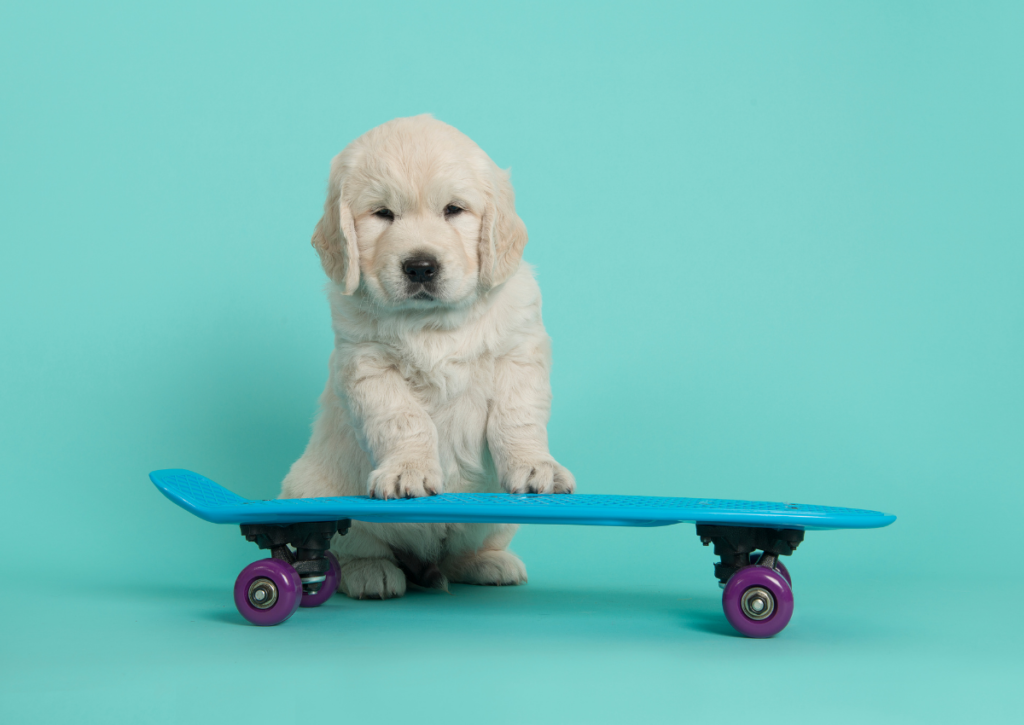

What Health and Wellness Tips Should You Know?
Vet Exam Basics
What To Expect During Your Puppy’s First Exam
When you arrive at your vet’s office, the staff will typically get you checked in, weigh your puppy, and may ask you some basic information. Your vet should then:
- Discuss your puppy’s history or basic information.
- Listen to their heart & lungs.
- Take their temperature using a rectal thermometer (getting a cold object up the bum can be scary, so give encouragement in a soothing voice, then lots of treats).
- Examine eyes, ears, mouth, teeth, nose, feet, & their genitals.
- Examine skin & coat.
- Feel their abdomen & lymph nodes.
- They may ask you to bring a poop sample to check for worms, and administer or prescribe de-worming medications (wondering what the heck to put poop in? A sealed plastic sandwich bag is fine!).
- Discuss heartworm & flea/tick preventative options.
- Administer your pup’s first DA2PP vaccine & discuss their booster schedule.
- Answer any questions you have about daily care, health issues, and medications, as well as future care decisions like spay/neuter, microchipping, or any breed related concerns.
Topics To Discuss To Prep For The Future
There are a few things you’ll want to discuss with your vet at the first visit so you can plan for your puppy’s future appropriately. These include:
- Spaying or neutering: This is your chance to ask about the procedure and when your puppy should receive it (breed and size play into this decision).
- Microchipping options (usually done during spay/neuter).
- Future vaccine schedule.
- Pet insurance options and how it works.
- Preventative measures for any breed-related health issues (for exmple, gastropexy for large breed dogs, supplements, vitamins, etc).
Vaccinations
Puppies are born with a small amount of natural immunity courtesy of their mom during birth, and through her milk when they’re nursing. However, puppies’ natural immunity is equal to only about 5% of that of Mom’s, and it wears off within the first three months of a puppy’s life. That means that without vaccines, your puppy is extremely vulnerable to harmful diseases and has almost no immunity against them1. This is why it’s vital to follow your vet’s recommended vaccine schedule.
When Should My Puppy Get Vaccinated?
Core puppy vaccinations (must-have vaccines) usually start at 8 weeks old and are administered every 2–4 weeks until your puppy is 16 weeks old1. They will need yearly boosters of these vaccines throughout their life to keep up their immunity. Non-core puppy vaccinations are given depending on your puppy’s lifestyle—timing varies for each vaccine1. These are usually recommended if you plan to take your pup to more crowded spaces, like doggy daycamp or pet hotels, where these diseases are spread more easily.
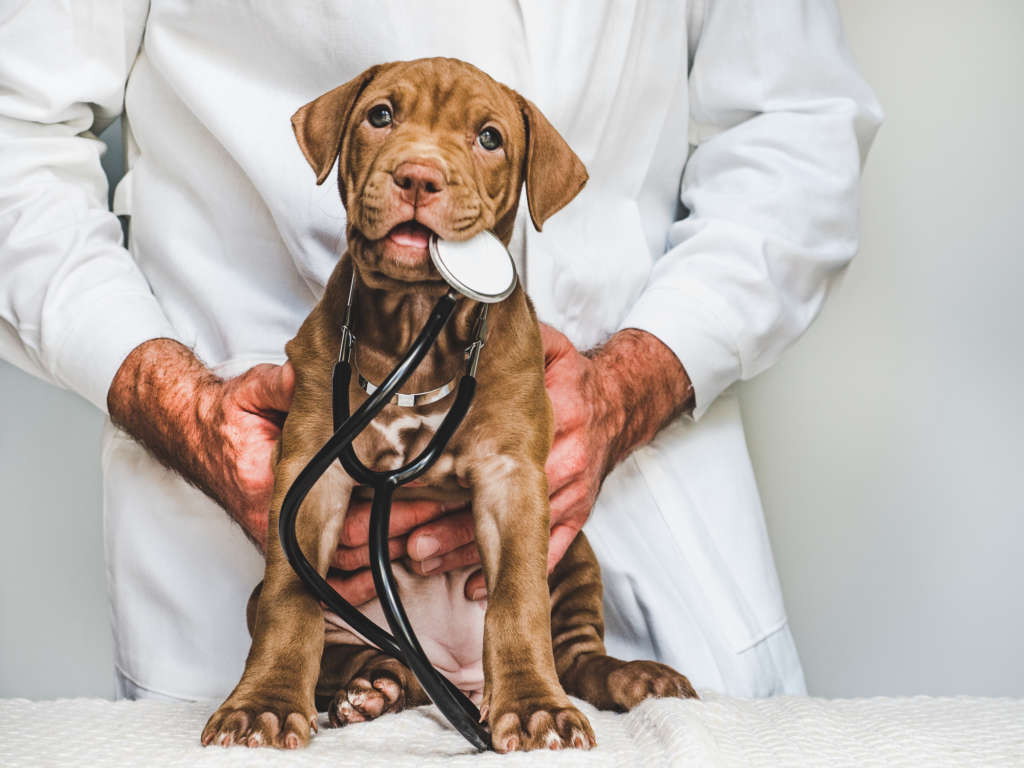

Core Puppy Vaccines Necessary At 8–12 Weeks1:
Distemper, parvovirus, adenovirus2 and parainfluenza vaccines are often given as a single injection listed as DA2PP or DAP on your pup’s records, and is commonly referred to as the “distemper vaccine1.”
- Distemper: Causes respiratory, neurological, and gastrointestinal illness. It’s highly contagious with a mortality rate at 50% (worse in puppies).
- Parvovirus: Causes severe GI disease, which can be fatal. It’s most common in puppies under 6 months old and highly contagious.
- Adenovirus2 (hepatitis): Causes respiratory disease.
- Parainfluenza: Causes upper respiratory tract disease and is contagious in high-density settings, like at doggy daycamps.
Socializing Dos and Don’ts Before Your Puppy Is Fully Vaccinated
- Do socialize your puppy with older, vaccinated dogs that you know well (your friends’ or family’s dogs).
- Do introduce your puppy to new humans.
- Do ask your vet about their recommendations for puppy socialization classes.
- Do carry your puppy in your arms in public places such as pet stores and vet offices until they are fully vaccinated.
- Don’t take your puppy to a dog park before they are vaccinated.
- Don’t let your puppy play with other unvaccinated puppies or dogs (unless your vet has ok’d this for puppy class socialization).
- Don’t let them swim in stagnant bodies of water that may contain dangerous amoebas or parasites.
Deworming & Heartworm
Heartworms are exactly what they sound like: literal worms that invade and live inside a dog’s heart. Heartworm disease is transmitted through mosquito bites, and is deadly without treatment. Most heartworm preventatives can be started around 6 weeks old and is given once per month for life7. If these preventatives have not been given before bringing your puppy home, make sure to discuss options with their vet during the first exam.
Puppies of any age can also have GI parasites such as roundworms, hookworms, tapeworms, and protozoa like giardia. These can cause diarrhea, nausea, and appetite changes. De-worming may also be done at the first puppy visit around 8 weeks1.
Flea & Tick
Most flea and tick preventatives can be started around 8 weeks old. Not only are fleas and ticks annoying and uncomfortable for your pup, but fleas are known to be the leading cause of tapeworms in dogs. Additionally, ticks carry all kinds of nasty, deadly diseases like Lyme disease, Rocky Mountain fever, ehrlichiosis, and anaplasmosis that can be transmitted to both dogs and humans. Talk to your pup’s vet about different treatment options, including:
- Topical vs oral flea & tick treatment
- Flea & tick shampoos
- Flea collars
- Flea combs
Pet Insurance
Most pet insurance companies work differently than human health insurance. The difference is that you have to pay upfront and get reimbursed later8. However, some large home/auto insurance companies are beginning to change this so that pet insurance works more like ours. It’s best to purchase pet insurance when your puppy is young; if you wait to sign up until your dog is older and already showing signs of a health problem, they may deny coverage for these pre-existing conditions.
Related Article: Is Pet Insurance Worth It For Your Dog?


Food & Nutrition
Puppy Digestion
Your puppy’s gastrointestinal system (a.k.a. their digestive system) is immature and finicky after weaning from Mom. Try not to feed them too much too fast while they’re maturing, and remember that small breeds are going to digest their food faster1.
Recommended Feeding Frequency By Age & Size1:
- Extra-small & small breeds: Feed 3x daily until 4 months, then 2x daily
- Medium breeds: Feed 3x daily until 6 months, then 2x daily
- Large & giant breeds: feed 3x daily until 6 months, then 2x daily
Always do you own research when picking the perfect food for your pup, but if you need a place to start, try BARK Food for puppies! Get 25% off and forever free shipping with code 25FOOD.
Puppy Ideal Body Weight
The internet has a way of celebrating chunky pets for their cuteness, but allowing your puppy (or dog) to become overweight is straight-up unfair to them. Obesity is not only going to lead to health problems and joint pain, it also keeps your puppy from being able to enjoy a happy, active lifestyle. Your veterinarian can help you learn how to assess the proper weight for your pup, but as a general guideline, you’re going for the “hourglass” figure1:
- When viewed from above, your puppy should be narrow at the waist.
- When viewed from the side, your puppy’s belly should tuck up after the ribcage.
Note: When they are really young (8–12 weeks old), puppies may not yet be grown enough to look like this (they often don’t have a waist yet), so let your vet help guide your interpretation, especially early on.1
Guide To Puppy Food (Why It’s Important)
Choosing A Puppy Food
By the time you bring your puppy home at 8 weeks old, they’ll need a proper diet formulated with extra calories and nutrients for their rapidly growing bodies.
Here’s what to look for:
- Food specifically labeled as “puppy” or “all life stages.”
- Packaging stating that it follows AAFCO Guidelines (The Association Of American Feed Control Officials).
- If you have a large or giant breed dog, look for food labeled as “large breed puppy” or “giant breed puppy.” These breeds are prone to arthritis and hip dysplasia later in life, so these specialized puppy foods contain lower amounts of calcium and phosphorous, but higher amounts of fiber.
Want some more details about the differences between puppy and adult food? We got you!
Transitioning To A New Food
With puppies and dogs of any age, you always want to transition diets gradually to avoid digestive stress (and diarrhea). An ideal transition schedule looks like:
- First 2 days: 25% new food + 75% original food
- Next 2 days: 50% new food + 50% original food
- Next 2–3 days: 75% new food+ 25% original food
- Finally 100% new food
If your puppy still experiences some tummy trouble at this transition speed, you can always do an even more gradual switch over two weeks rather than one.
Food & Water Routine
- Dogs crave structure & routine, so feeding from the same bowl, in the same place, at the same time is ideal.
- Always maintain unlimited access to fresh water.
- Clean their bowls and change water at least once daily.
Guide To Puppy Treats
Treats are one of your best tools for puppy training. I mean, who isn’t encouraged by delicious food? But since we’re tossing out treats left and right trying to teach our puppies “how to dog,” it’s important to remember that treats (meaning anything other than kibble) should not exceed 10% of their daily caloric intake9. This goes for both puppies and dogs.
The trick is to choose smaller training treats, break treats into smaller pieces, or choose treats with fewer calories (like pieces of carrot). The best treats for puppies are going to be small, soft-chew treats perfectly suited for their small mouths and developing jaws and teeth.
General dog treat safety info is only a click away!
Safe Human Food Treats For Puppies1
- Raw baby carrots (50 grams provides 18 kcal)
- Boiled carrots (78 grams or about 1/2 cup provides 27 kcal)
- Boiled summer squash (zucchini) (180 grams or about 3/4 cup provides 28 kcal)
- Baked butternut squash (51 grams or about 1/4 cup cubed provides 21 kcal)
- Boiled spinach (90 grams or about 1/2 cup provides 21 kcal)
- Boiled green beans (63 grams or about 1/2 cup provides 22 kcal)
- Raw apple with skin (31 grams or about 1/4 cup chopped provides 14-16 kcal)
- Watermelon (76 grams or about 1/2 cup diced provides 23 kcal)
- Raw pear (35 grams or about 1/4 cup of slices provides 20 kcal)
- Sliced raw peaches with peel (1/4 cup provides 18 kcal)
- Honeydew melon (44 grams or about 1/4 cup balled provides 16 kcal)
- Strawberry (12 grams or about 1 medium berry provides 4 kcal)
- Sliced strawberry (43 grams or about 1/4 cup sliced provides 14 kcal)
- Mashed banana (28 grams or 1/8 cup mashed provides 25 kcal)
- Banana (34 grams or about 1/4 of a large 8”-9” nanner provides 30 kcal)
- Applesauce (1 tablespoon of provides 6 kcal)
- Miniature marshmallows (10 minis provides 22 kcal)
- Honey (1 teaspoon provides 21 kcal)
- Air-popped popcorn/no salt or butter (1/2 cup provides 16 kcal)
Foods & Substances Toxic To Puppies & Dogs10
- Alcohol
- Antifreeze
- Caffeine
- Chocolate
- Cigarettes, nicotine, e-liquid for electronic cigarettes
- Compost
- Dishwashing liquid, detergent/dishwasher tablets
- Fabric softener sheets
- Grapes & raisins
- Ibuprofen & naproxen
- Cannabis
- Minoxidil (Rogaine)
- Mosquito repellant with DEET
- Nasal decongestants
- Nuts (particularly macadamia nuts)
- Onions, garlic, chives
- Pesticides & rodenticides
- Topical medications
- Wild mushrooms
- Xylitol
- Yeast dough


Training
Potty Training 101
Besides socialization, potty training is one of the most important things to teach your puppy in this early stage. Just like kids, puppies are little sponges when it comes to learning—they soak up everything. Okay, so they may soak the floor with pee puddles a couple of times in the process, but with patience and encouragement, they should understand the basics within a few weeks11. Remember that puppies at this stage have very tiny bladders and quite literally cannot “hold it” long10.
The Keys To Potty Training A Puppy12:
- Take them outside frequently & on a schedule to a designated spot in the yard. Having a spot where they recognize their own scent helps them learn “this is my pee spot!”
- Praise them EVERY time they go potty outside. Give them a treat & an encouraging “YAY! GOOD GIRL/BOY!” as soon as they finish. Some extra playtime afterwards helps turn it into an enjoyable experience. Keep in mind not to excite them with treats, praise, or play DURING or BEFORE they finish.
- Avoid accidents in the house by keeping a close eye out & confining them to a space where they’re allowed to roam.
- NEVER punish or “rub their nose in it” when they have an accident. Instead, take them outside immediately after the accident, or if you catch them in the act, try to stop them and get them outside without yelling or scaring them1. Associating praise with going potty in the right spot outside is going to help their little noggins understand what you want quicker than yelling at them for peeing, which is confusing to a growing puppy brain.
- A general rule is that puppies can “hold it” for about one hour for each month of age—so at 2 months old, they should be able to wait about 2 hours without needing to go potty.
When Puppies Need Potty Breaks To Avoid Accidents10:
- When they wake up in the morning
- Right before bed
- After eating
- After drinking water
- After naps
- During play/lots of activity/excitement
- If they wake up during the night
Puppy Biting 101
Puppies and dogs use their mouths for everything, so it only makes sense that they’re going to be chompy and bitey by nature. Their littermates, as well as older dogs, help to teach them to bite with the appropriate amount of force, but it’s your job to assist with this by understanding the dos and don’ts of puppy biting13:
Do:
- Do calmly let out a high-pitched “OW!” or “OUCH!” sound when your puppy bites you too hard during play, & immediately pause play for a few seconds until your puppy calms down.
- Do praise them with a “good boy” or “good girl” once they calm down, & continue play.
- Do repeat these steps no more than 3–4 times in 15 minutes. If your puppy isn’t startled or actually becomes more rambunctious when hearing your cries, you may need to try other methods.
- Do encourage them to be even gentler once they start to get the hang of controlling their really hard bites. Make your “OW!” noises with moderately hard bites, & then move on to lighter bites.
- Do be patient with this process. Biting is normal for puppies & is part of their learning process. It can take up to 6 months for them to learn that teeth on skin is not okay.
Do Not:
- Do not bite back if your puppy bites you. At best, you’re going to end up with a mouth full of fur, at worst you’re going to hurt them & teach them to be afraid of you.
- Do not use your hands as toys by tapping them in front of your puppy’s face to play. This will only do the opposite & teach your puppy that fingers are fun to bite and play with.
Other Things To Start Teaching Your Puppy In The First Month Home
- Their name! This can be learned in as little as 1–3 days. Use their name often & always in positive situations.
- How to walk on a leash.
- How to sit.
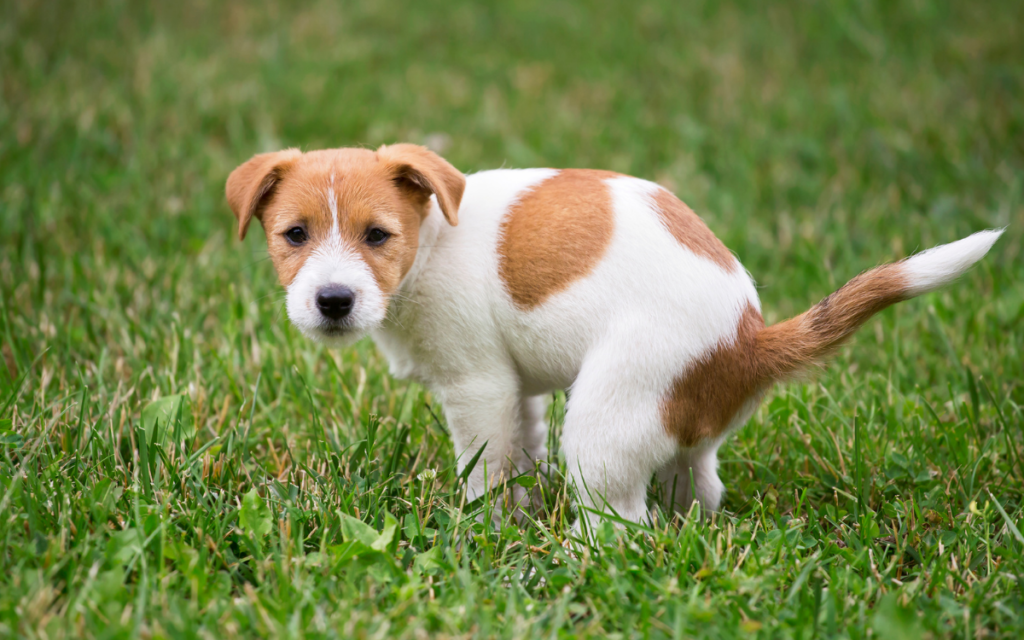

Safety & Puppy Proofing
Puppy Proofing The House
As exciting as a new puppy is, it’s also nerve-racking once you realize that the minute you sit them down, they’re already looking for trouble. Like bee-lining straight for your phone charger with their tiny, wire-cutting teeth. In the first 8–12 weeks, puppies are still sleeping a lot and are relatively easy to keep track of, but there are some basic steps you need to take to puppy-proof the house and keep them safe.
- Pick up electrical cords/charging cables and set them out of reach.
- Store “not-for-puppy” items out of reach (shoes go in the closet!).
- Store hazardous household products on high shelves or in locked closets.
- Put down non-slip material where needed (yoga mats, runners). These do not need to cover every square inch, but each area should have a place with good traction where your puppy can feel secure with their footing.
- Inspect yard for holes in the fence, metal lawn edging (probably the most frequent cause of at-home paw lacerations; they can be bad enough to sever tendons), poisonous plants, or chemicals (herbicides, fertilizer, antifreeze).
- Check that all outer doors latch shut properly and can’t be pushed open with a puppy nose.
- Use child locks and baby gates when necessary (especially with stairs in this first month home).
- Place furniture protectors on any furniture you don’t want chewed on, peed on, or covered in fur.
- Remove poisonous plants from house or place out of reach.
- Put all medications in a safe place.
Safety When Traveling
The amount of videos with people driving cars with puppies in their lap are too damn high! Not only does this put your puppy at risk of becoming a flying projectile in an accident, but a puppy crawling in your arms while driving can be what causes an accident in the first place. Don’t do it!
- Do not allow your puppy to roam freely in a moving vehicle.
- Use a secured crate or a harness attached to seat buckle to secure them. Never attach a puppy seatbelt directly to their collar—this can cause strangulation in an accident or if they slip off the seat.
- Never let puppies or dogs ride in the bed of a truck.
- Child lock the doors and windows while driving. Puppy paws have ways of unknowingly hitting buttons. (As a dog parent myself with a dog-loving family, a relative’s experience with their energetic dog bouncing loose in the car, hitting the window button, and FALLING OUT OF THE CAR became a cautionary tale for every pet parent. Luckily, their pup was okay, but they learned that lesson the hard way, and I’m sharing it with you all to avoid ever experiencing a similar situation with a worse outcome.)
Toy Safety1
- Rubber toys should be soft enough to make a fingernail indent, otherwise they’re too hard for fragile puppy teeth.
- Soft toys need to be thrown out once the stuffing has been pulled out—a.k.a. a fluff-ectomy—and squeakers need to be taken away. Both can become choking hazards.
- Choose appropriately sized toys for their mouth, & scale up as they grow.
- Remove any broken, damaged, or torn pieces before they can become a choking hazard.
- ALWAYS supervise toy time and never leave toys in your dog’s crate. No toy is 100% puppy safe, as anything can become a foreign body with a risk of intestinal obstruction if swallowed, or can fracture teeth.
Identification (ID Tags & Collar)
It’s time to commit to Captain Wigglesworth’s name and etch it onto his ID tag! Don’t delay getting your pup his first collar and tag with at least your phone number listed in case he ever gets lost. You can check out more ID options, GPS collars, and microchipping when he gets a bit older.
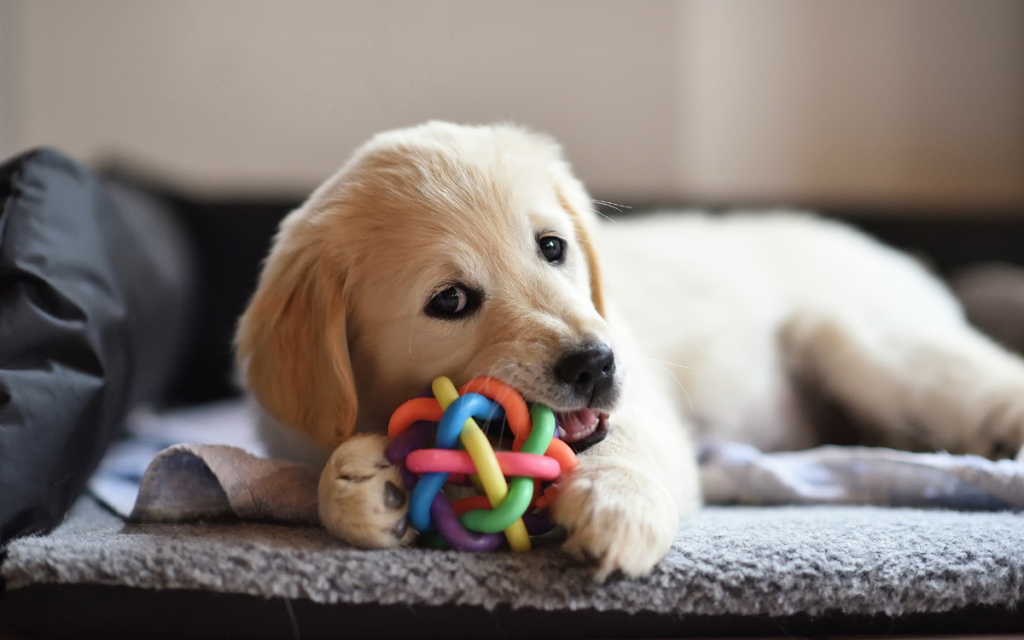

Puppy Products To Purchase In The First Month
Necessities:
- Puppy food
- Food & water bowls
- Collar
- Leash
- ID tag
- Training treats
- Crate (small enough that puppy can stand up and turn around, but not too big that they can potty in one area & sleep in another)
- Poop bags
- Cleaning supplies (stain & odor remover, towels)
- Your city may require a dog license or registration
- Flea, tick, & heartworm preventatives (ask your vet)
- TOYS!
Other Helpful Products:
- Harness
- Dog bed or blanket
- Dental care supplies (toothbrush, toothpaste for dogs, finger brush)
- Potty training bells
- Pee pads
- Nail clippers
- Ramps, stairs, or carriers for small dogs
- Supplements for large breeds
- Clicker
- Bitter apple spray
- Brush for their coat type
- Puppy gate or play pen
- Travel kennel or seatbelt
Emergency Resources
ASPCA Animal Poison Control
If your puppy eats something they shouldn’t, call the animal control poison center at (888) 426-4435.
Emergency Vets
If your puppy has an emergency when their regular vet is closed, you may need to find a 24/7 emergency vet near you. Emergency Vets USA enables you to search for an emergency vet by state or call (855)-778-6815.
Lost Pet
National hotline for reporting lost pets 1 (800) 486-2631.
Dog CPR How-To
Dog CPR Quick Guide
Dog CPR Training Video
Choking Dog/Dog Heimlich Maneuver
Dog Heimlich Maneuver Training Video
Sources
1Hennet, Margo. “Puppy Survival Guide.” 2 Mar. 2022.
2Lewis, Georgia. “Musculoskeletal Development of the Puppy Birth to Twelve Months.” Research Gate, Hartpury University: Animal Therapy Magazine: Issue 15, 2019, https://www.researchgate.net/profile/Georgia-Lewis/publication/333118590_Musculoskeletal_Development_of_the_Puppy_Birth_to_Twelve_Months/links/5cdc8200299bf14d959c443d/Musculoskeletal-Development-of-the-Puppy-Birth-to-Twelve-Months.pdf.
3Merck Veterinary Manual, 10 Feb. 2022, https://www.merckvetmanual.com/dog-owners/digestive-disorders-of-dogs/dental-disorders-of-dogs?query=puppy+teeth.
4Andrew. “Dog Dew Claws: Injuries, Trimming & Removal | Walkerville Vet.” Walkerville Vet, 2019, https://www.walkervillevet.com.au/blog/dog-dew-claws/.
5Reisen, Jan. “How Much Sleep Do Puppies Need? Here’s How to Make Sure.” American Kennel Club, American Kennel Club, 29 Apr. 2021, https://www.akc.org/expert-advice/health/how-much-do-puppies-sleep/.
6Youngerman, Claire. “House-Training Your Puppy.” Animal Health Topics , UC Davis | School of Veterinary Medicine, 24 Nov. 2021, https://healthtopics.vetmed.ucdavis.edu/health-topics/canine/house-training-your-puppy.
7Brooks, Wendy. “Heartworm: The Parasite.” Veterinary Partner, VIN, 1 Jan. 2001, https://veterinarypartner.vin.com/default.aspx?pid=19239&id=4951491.
8Young, Amy. “Benefits of Pet Insurance.” Animal Health Topics / School of Veterinary Medicine, 6 Dec. 2020, https://healthtopics.vetmed.ucdavis.edu/health-topics/discover-benefits-pet-insurance.
9“Frequently Asked Questions & Myths – WSAVA.” World Small Animal Veterinary Association , Jan. 2018, https://wsava.org/wp-content/uploads/2020/01/Frequently-Asked-Questions-and-Myths.pdf.
10DeGioia, Phyllis. “What First Time Puppy Owners Should Know.” Veterinary Partner, VIN, 28 June 2021, https://veterinarypartner.vin.com/default.aspx?pid=19239&id=10330034.
11Bukowski, John A., and Susan Aiello. “Puppy Care – Dog Owners.” Merck Veterinary Manual, Merck Veterinary Manual, 28 Feb. 2022, https://www.merckvetmanual.com/dog-owners/routine-care-and-breeding-of-dogs/puppy-care?query=puppy+development.
12“Indoor Pet Initiative.” Housetraining , The Ohio State University: College Of Veterinary Medicine, https://indoorpet.osu.edu/dogs/puppy/housetraining-dogs.
13“Indoor Pet Initiative: Socialization.” The University Of Ohio State: College Of Veterinary Medicine, https://indoorpet.osu.edu/dogs/puppy/socialization.

